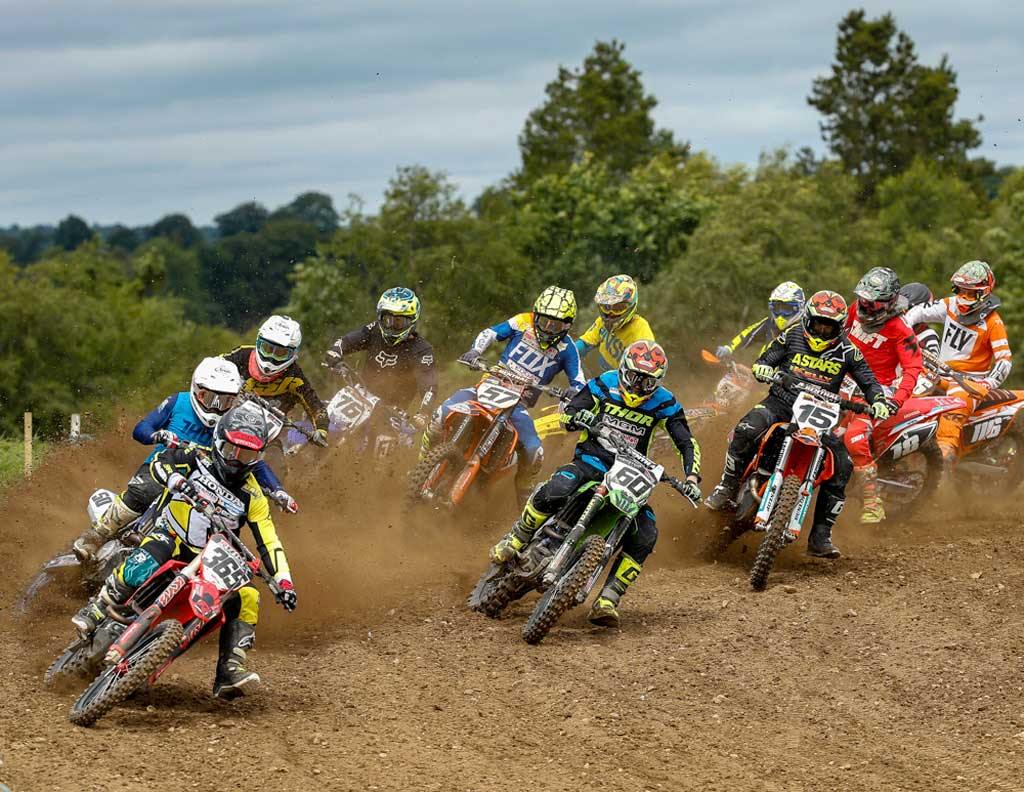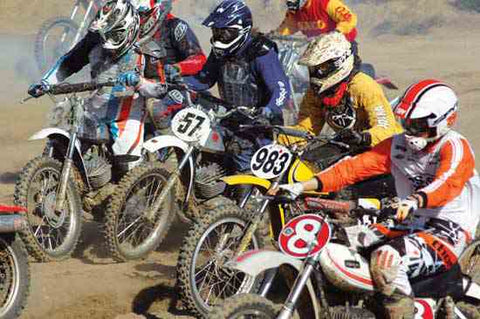Your Cart is Empty
MX Products
shop your way
MOTO TIRES
MX Gear & Apparel
How Do Motocross Races Work? How Long, How Many, and How Much?
January 25, 2022

If you’ve recently found yourself getting into motocross, you might have noticed the rules aren’t as straightforward as riders winning a race. There are numerous aspects to consider in motocross racing, including the different races, the dirt bike classes, and how each of these features operates in the world of motocross.
Pro Motocross races are typically made up of 30-minute motos and additional laps. Amateur races are much shorter anywhere from 8-15 minutes typically. Each race will host a rider’s meeting before the race begins to determine the race schedule, time constraints, number of laps, and the point system involved in the race.
Still confused about how motocross races work? That’s ok, there are a few things to be explained and we appreciate why it’s not easy to understand. Read on below to find out how motocross races work, how long the races generally go for, and how much it costs to race. You’ll be able to explain motocross to anyone once you’ve read our simple guide.

How Many Laps is a Typical Motocross Race?
Typically, an outdoor motocross event sanctioned by the American Motorcyclist Association (AMA), will have what we call two “motos”. Motos run for thirty minutes each, plus two laps at the end of each 30-minute moto.
Riders are awarded points based on the position in which they finish the race.
Here is a table of how the point system works for the position you finish in the race:
| Position Finished | Points Awarded | Position Finished | Points Awarded |
| 1st | 25 | 11th | 10 |
| 2nd | 22 | 12th | 9 |
| 3rd | 20 | 13th | 8 |
| 4th | 18 | 14th | 7 |
| 5th | 16 | 15th | 6 |
| 6th | 15 | 16th | 5 |
| 7th | 14 | 17th | 4 |
| 8th | 13 | 18th | 3 |
| 9th | 12 | 19th | 2 |
| 10th | 11 | 20th | 1 |
Because there are two motos in each class of the event, the winner is the person who finishes with the highest point total.
For example, if you came 1st in each race, you would receive a total amount of 50 points and would be the overall winner of your event.
Simple right? Wrong.
If you happened to come 1st in your first race and then 2nd in your second race and one of your opponents was 2nd in the first race and then 1st in the second race, they would win even though you both have the same total of points.
The reason the AMA scores this way is so that any possible ties are essentially ‘broken’ by the better performer of the second moto race. So, there are no ties and we have a clear winner.

How Many Riders are in a Motocross Race?
Most motocross tracks will be able to host at least 25-30 riders in one race on the same track. Whoever finishes after 20th place, will have a score of zero. This doesn’t mean they will lose though, as they could come back and place higher in the next moto for a total of up to 25 points which in turn could score higher than whoever won the last race if they don’t do so well in the second moto.

How Much Does It Cost to Race in Motocross?
Motocross involves membership fees, usually annual, as well as entry fees into pretty much every race you enter.
If you have sponsors, they may cover the entry fee for you, but don’t ever expect it, and always be prepared to pay your race entry fees.
As much as we love motocross and dirt bike riding, sometimes it doesn’t come cheap and that’s one of the main reasons why a lot of people can’t participate in all the events they’d like to. But, the event hosts need to maintain and keep the tracks running so it makes sense that we do have to pay our dues.
Here’s what you need to keep in mind when it comes to motocross costs:
-
You need a bike and riding gear.
You can get bikes pretty cheap if you’re looking second-hand or a model that isn’t as well known as brands like Honda, Suzuki, Yamaha, etc. but that doesn’t mean it’s necessarily a good bike.
Of course, some people have taken their chances and their chances have paid off.
Then there’s riding gear, including helmets, trousers, knee pads, gloves, goggles, and much, more. It’s all necessary for your safety so you’ll want to ensure you spend the money on the right gear and that it’s good quality gear that’s going to last you a while.
-
Think maintenance.
If you do happen to get a lesser-known bike model or a second-hand one, you might be up for more maintenance fees than you realize. Sometimes it’s better to get a slightly more expensive bike that doesn’t need as much maintenance to save you money in the long run.
-
Membership fees.
To ride in pro motocross races, you must be a member of the AMA. It’s basically like insurance for your right to ride and it comes with some discounts on listed services and gear.
You can check out the AMA fees on their official website here but for purpose of this blog, you’re looking at $49 for a yearly membership.
-
Race entry fees.
To enter yourself into a motocross race, sometimes you have to pay entry fees. Entry fees may go towards the winning prize money depending on the event you entered into. Fees might range from $30 – $50 per class.
-
Accommodation, food, miscellaneous.
Don’t forget to consider that these races are hosted all over the country, far and wide, and aren’t always a short drive away. If you have friends in the area, great, you’ll save some costs.
You’ll need to think about accommodation, food, fuel, and other expenses if the racetrack is further away from home.
What are the Different Classes in Motocross?
Since off-road motorcycling was founded in the early 1900s there have been numerous changes to each group classification. Changes have been made to reflect the constant progression of engine and motor technology and the powerful changes that have been made to dirt bikes over the years.

Depending on the event, the classes may have different names and there are separate events held for men and women in most motocross races.
Here is a quick guide to the classic motocross classes you’ll find in the top two championship events, the AMA Motocross Championships and the FIM championships. There are other classes in motocross that you might be interested to know more about depending on your skill level, age, and what engine your bike has if you’re eager to enter some races.
For further guidance on the different classes in motocross, you can read our “What are the Different Motocross Classes?” guide here.
AMA Motocross Championships (American Motorcyclists Association)
The AMA Motocross Championships, founded in 1972, has three classes including one for women.
450 MX Class
The 450 MX class allows for 250cc 2-stroke bikes and 450cc 4-stroke bikes.
250 MX Class
The 250 MX class allows for 125cc - 150cc 2-stroke bikes and 150cc – 250cc 4-stroke bikes
Women’s MX
The women’s MX class allows for 120cc – 250cc 4-stroke bikes

FIM Motocross World Championship (Fédération Internationale de Motorcyclisme)
The FIM Championships host three classes in this event including a class for women. The FIM Championships did host 4 classes at one time, including a class for women.
MXGP Class
The MXGP has changed names numerous times, depending on who you speak to about motocross they may still refer to this class as the MX1.
The MXGP Class allows for 2-stroke bikes up to 250cc and 4-stroke bikes up to 450cc.
MX2 Class
The MX2 class allows for 2-stroke bikes up to 125cc and 4-stroke bikes up to 250cc.
MX3 Class
The MX3 Class allows for 2-stroke bikes up to 500cc and 4-stroke bikes up to 650cc.
Women’s MX
Since 2014, the MX3 class has been replaced with a women’s class. The bikes used in the women’s MX class are 122cc – 250cc.

What is the Flag System?
Like all motorcycle racing, motocross also has a flag system to notify riders and spectators of information that is relevant to the event.
Here are the flag colors you might see during a motocross event and what they mean:
Red Flag – Immediate Stop
The red flag signals to racers that they need to slow down, advance slowly and cautiously to their pit and stop the race. This might be due to injury on the course.
Yellow Flag – Caution
This flag signals that there is an obstruction on the course and for racers to show caution. You must slow down but you can still pass other racers.
White Flag – Final Lap
The white flag is for individual riders to let them know when they are on their last lap of the race.
Green Flag – The Beginning
The green flag signals the start of the event as well as the okay to go ahead or continue after another colored flag might have slowed down the race (yellow or red for example).
Blue Flag – Overlap Warning
Nobody wants to see any flag other than the green and the checkered flag. But the blue flag might make you pick up your game as it shows you’re going to be overlapped and left behind.
If you see the blue flag with a yellow stripe through it, this is an indicator that another racer is going to overlap you. You might want to change the gears and step on it.
Black Flag – Individual Rider
The black flag indicates that an individual rider needs to stop the race immediately and report to officials. The rider’s race number will be placed on a board large enough for them to see they need to stop their race event and clear the track.
Red-Cross Flag – Medical Personnel
The red-cross flag shows riders that medical personal and/or equipment are either on the track or close to the track. Riders will need to proceed with caution and slow right down. You cannot pass another rider when the red-cross flag is signaled.
Checkered Flag – The End
The checkered flag signifies the end of the race. When you see the checkered flag waving, you’ve finished your final lap and you’ll receive your placing position in the race.

Conclusion
Now you know the basics of the motocross world. The different classes, how long the races go for, the flag system, and the costs you can typically expect to spend on motocross racing. Dirt bike riding is a thrilling experience, whether you’re riding or spectating. We can’t recommend motocross enough and the events are always a good day out for the whole family, especially if you all understand what’s going on throughout the event.
Keep Learning
- How Can I Watch AMA Supercross or Motocross in 2023? (Stream or Channel?)
- What Are the Different Motocross Classes? MX, SX, Amateur, Kids & More
- How Does the Point System Work In Supercross?
- How Are Motocross Numbers Assigned?
- How to Qualify for Motocross?
- What is the Difference Between Motocross and Supercross?
Leave a comment
Comments will be approved before showing up.
From The Shop
Join the Risk Racing Community
Be in the know! Subscribe for exclusive offers, product launches, and insider tips. Don't miss out!































